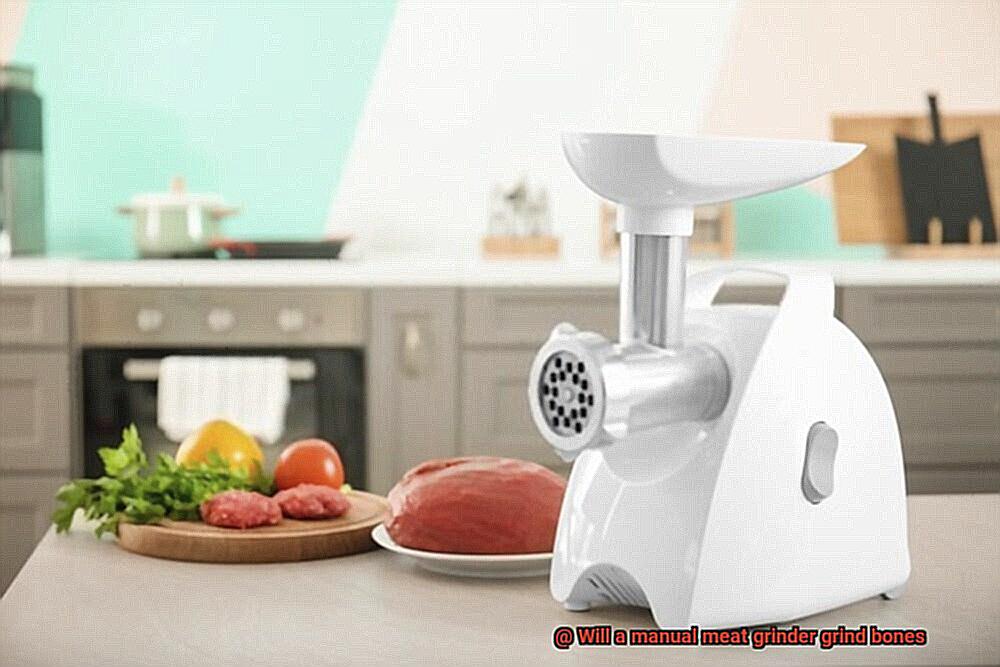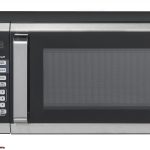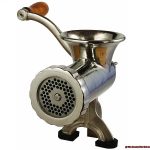Hey there, fellow meat enthusiasts. Are you tired of settling for store-bought ground meat that’s lacking in flavor and freshness? Maybe it’s time to take matters into your own hands and start grinding your own meat at home. But what if you want to go a step further and add some bone-in goodness to your meals? Can a manual meat grinder handle the task?
This question has sparked debates among carnivores everywhere. The idea of grinding bones may seem unorthodox, but it’s actually quite common in certain cuisines, especially when making pet food or bone meal supplements. So, can a manual meat grinder really grind bones?
Fear not, my curious friends. In this blog post, we’ll dive deep into the world of manual meat grinders and explore their bone-grinding capabilities. We’ll take a look at the different types of manual meat grinders available and discuss important factors to consider before attempting to grind bones.
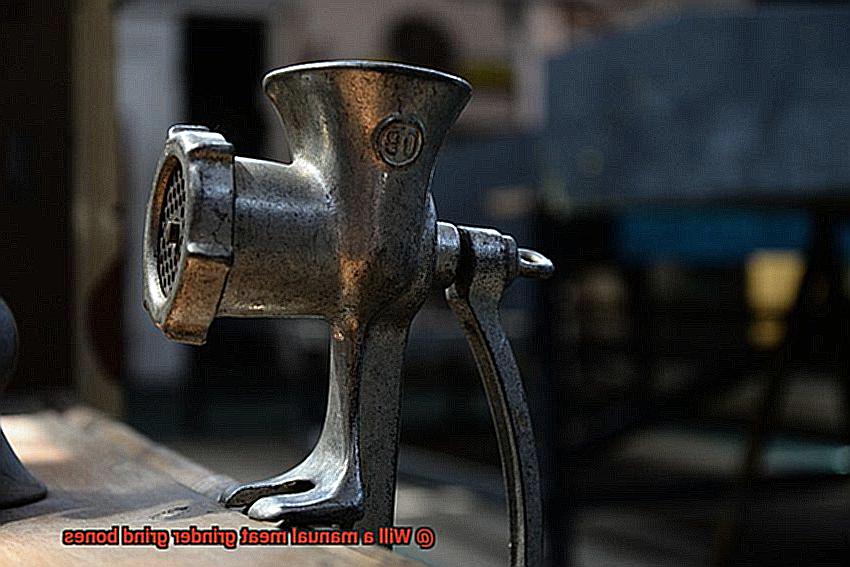
Whether you’re a daring chef looking to add some extra oomph to your dishes or a pet parent wanting to make homemade food for your furry friend, keep reading to find out if a manual meat grinder is up for the challenge.
Contents
What Is a Manual Meat Grinder?
A manual meat grinder typically consists of a hopper, a handle, and a set of blades or grinding plates. The hopper is where the meat is placed, and the handle is used to rotate the blades or plates. This allows the meat to be ground to your desired texture and consistency.
But that’s not all – manual meat grinders come in various sizes and designs, from small handheld models to large countertop versions. They’re often constructed from durable materials such as stainless steel or cast iron, ensuring they’ll last for years.
The biggest advantage of using a manual meat grinder is that it gives you complete control over the texture and consistency of your meat. You can adjust the size of the grinding plates to get coarse or fine ground meat, making it perfect for everything from hamburgers to meatballs.
Manual meat grinders are also affordable and easy to use, making them a popular choice for home cooks who want to grind their own meat at home. Plus, they’re an excellent way to save money on pre-packaged ground meat while reducing waste.
However, it’s essential to note that manual meat grinders aren’t built to grind bones, especially denser ones found in beef or pork. Attempting to do so can damage the grinder and pose a safety hazard. For grinding bones for pet food or other purposes, consider investing in a heavy-duty electric meat grinder specifically designed for this task.
Can a Manual Meat Grinder Grind Bones?
The answer isn’t as simple as a yes or no. There are several factors that come into play when it comes to grinding bones with a manual meat grinder.
Firstly, it’s important to note that not all manual meat grinders are created equal. Some are specifically designed for grinding meat and cannot handle bones. However, if you’re looking to grind softer bones such as chicken or rabbit bones, then a manual meat grinder with a powerful motor and sturdy construction should be able to handle the job. On the other hand, if you’re planning to grind tougher bones like beef or pork bones, you may require a heavier-duty grinder with sharp blades and a strong motor.
In addition, the quality of your manual meat grinder plays an essential role in its ability to grind bones. Even if the grinder is designed to handle bones, a low-quality one may not be able to handle the task properly. Therefore, investing in a high-quality manual meat grinder with sharp blades and a strong motor can significantly improve your chances of successfully grinding bones.
It’s also worth noting that grinding bones can be a time-consuming and strenuous task, even with the best manual meat grinder. It’s vital to use caution and take breaks frequently to avoid overheating the machine or causing damage to the blades.
The Benefits of Using a Manual Meat Grinder
If you’re looking for a reliable and cost-effective way to grind your own meat, then a manual meat grinder is the perfect investment for your kitchen. As an expert in this field, I can tell you that using a manual meat grinder has many benefits that make it an excellent choice for home use.
One of the most significant benefits of using a manual meat grinder is that it allows you to control the texture and consistency of your ground meat. With an electric grinder, you’re limited to the settings on the machine, which may not give you the desired results. However, with a manual grinder, you can adjust the settings to your liking and get the perfect grind every time. This level of control is essential for chefs who need precise results in their recipes.
Another advantage of using a manual meat grinder is its affordable pricing. Unlike electric grinders, manual ones are more affordable, making them accessible to anyone who wants to grind their own meat without breaking the bank. Additionally, since manual meat grinders don’t require electricity, they are perfect for use in remote locations or outdoor settings where electricity may not be readily available.
Cleaning up after use is a breeze with a manual meat grinder since there are fewer parts involved. Many manual meat grinders are made from stainless steel, making them resistant to rust and other forms of corrosion. This durability makes them long-lasting and more durable than electric grinders.
In addition to grinding meat, some manual meat grinders come with attachments that allow you to grind other food items such as fruits, vegetables, and nuts. This versatility makes them a great addition to any kitchen, especially for those who like to experiment with different recipes. With a variety of attachments, you can explore new recipes and try out different ingredients without having to purchase multiple kitchen gadgets.
Lastly, using a manual meat grinder is a fun activity that can involve the whole family. It’s an excellent way to get kids involved in the kitchen and teach them about where their food comes from. Plus, it’s an excellent arm workout that will help you stay fit while preparing delicious meals for your family.
The Risks Associated with Grinding Bones in a Manual Meat Grinder
While it may seem like a good idea, there are several risks to consider before doing so.
Firstly, grinding bones in a manual meat grinder can damage the machine itself. Bones are much harder and denser than meat, which can cause the blades of the grinder to become dull or even break. This not only renders your grinder useless but also poses a safety hazard if broken parts fly off during operation.
Another significant risk associated with grinding bones in a manual meat grinder is the potential for injury to the user. Bones require more force to grind than meat, which means that users may need to exert more pressure on the grinder’s handle. This can lead to strain and injury, particularly if the user has any pre-existing conditions such as arthritis or carpal tunnel syndrome.
Moreover, grinding bones in a manual meat grinder can also lead to hygiene concerns. Bones have a higher risk of carrying harmful bacteria such as salmonella or E.coli, which can contaminate the grinder’s components. This contamination can then transfer to any other meat that is subsequently ground in the machine, posing a risk of foodborne illness.
To safely use your manual meat grinder for bones, it’s important to follow manufacturer guidelines and use caution when operating the machine. Additionally, it’s recommended that you thoroughly clean and sanitize your grinder after each use, especially if you’re grinding bones or other high-risk meats.
Alternatives to Grinding Bones in a Manual Meat Grinder
But fear not, there are several alternatives available to get the job done effectively and safely.
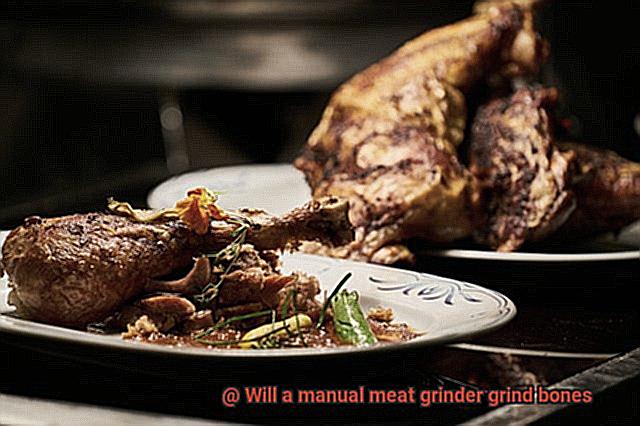
One of the best options is to use a food processor or blender. These machines are typically more powerful than manual meat grinders and can easily handle grinding bones. However, it’s essential to choose a model with a high-powered motor and durable blades designed for tough tasks like grinding bones. Not all food processors or blenders are created equal, so be sure to do your research before making a purchase.
Another option is the traditional mortar and pestle. While this method may seem old-fashioned, it’s an effective way to grind small amounts of bones for homemade pet food or other uses. Simply place the bones in the mortar and use the pestle to crush them into a fine powder. Although this method may take longer than using a food processor or blender, it’s a useful option for those without access to other equipment.
If you’re serious about grinding bones regularly, consider investing in a dedicated bone grinder. These machines are specifically designed for grinding bones and can handle even large and dense bones with ease. They come in both electric and manual options, so you can choose the model that best fits your needs and budget.
It’s important to note that while manual meat grinders may not be ideal for grinding bones, there are plenty of equally effective alternatives available. Whether you opt for a food processor, mortar and pestle, or dedicated bone grinder, always follow manufacturer guidelines and exercise caution when operating any equipment. And as always, thoroughly clean and sanitize your equipment after each use to ensure your pet’s safety and hygiene.
What to Look for When Buying an Electric Meat Grinder
If you’re in the market for an electric meat grinder, it’s important to know what to look for. Here are five key factors to consider:
Motor Power
The motor power of the grinder is the first thing to look for. It determines how quickly and effectively the grinder can grind tough materials like bones. Look for a grinder with at least 500 watts of power to ensure optimal performance.
Size and Capacity
Consider how much meat you will be grinding at once and choose a grinder with an appropriate capacity. A larger grinder typically has a larger feeding tube, making it easier to feed larger pieces of meat and bones. Keep in mind that larger grinders may be heavier and harder to store.
Durability
Look for a grinder made with high-quality materials like stainless steel or aluminum to ensure that it will last. Stainless steel blades are particularly durable and can easily handle grinding tougher materials like bones.
Ease of Use and Cleaning
Grinding meat can be a messy job, so it’s essential to find a grinder that is easy to operate and clean. Look for models with removable parts that are dishwasher-safe or easy to clean by hand. Grinders with simple controls and clear instructions are also ideal for ease of use.
Accessories
Some grinders come with additional attachments or accessories, such as sausage stuffing tubes or different grinding plates, which can expand their functionality. Consider your needs and choose a model with accessories that will benefit you.
How to Use an Electric Meat Grinder Safely and Effectively
Before you start grinding, it’s important to keep safety in mind. Here are five key tips for using your electric meat grinder safely and effectively:
Read the Instructions
Before using your electric meat grinder, read the manufacturer’s instructions carefully. This will help you understand how to use the machine correctly and prevent any accidents from occurring.
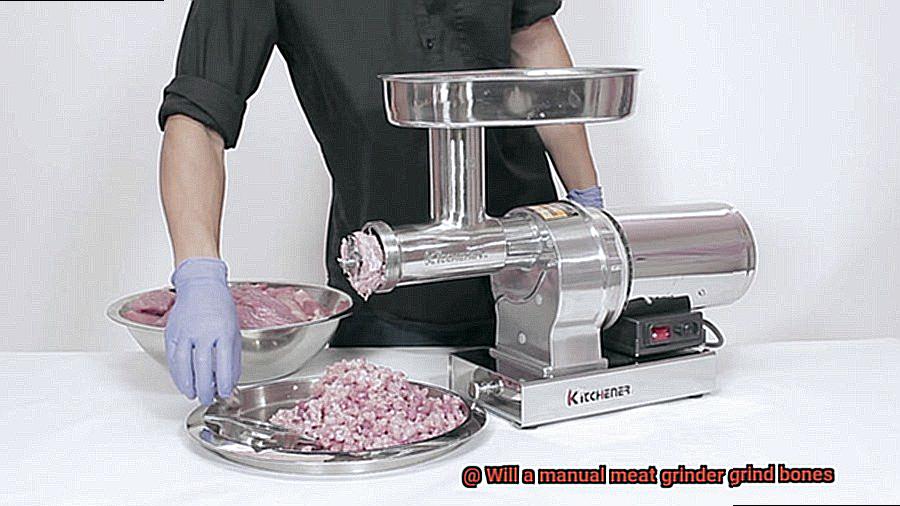
Set up the Grinder Properly
It’s important to set up your grinder on a stable surface that is not slippery or uneven. This will help prevent the machine from tipping over while in use. Additionally, make sure that the machine is properly grounded to prevent any electrical hazards.
Prepare Meat Correctly
When preparing meat for grinding, cut it into small pieces that will fit easily into the grinder. Keeping the meat as cold as possible will also help prevent bacteria growth.
Assemble and Secure All Parts
Before turning on the machine, make sure all parts are properly assembled and secured. This includes the blades, plates, and feed tube. Once everything is in place, turn on the machine and begin to feed the meat into the grinder using the provided food pusher.
Pace Yourself
It’s important to pace yourself when grinding meat to avoid overloading the machine. If you notice that the motor is struggling or making unusual noises, stop immediately and inspect the grinder for any clogs or issues.
Finally, once you have finished grinding your meat, turn off the machine and unplug it from the electrical outlet. Disassemble all of the parts and clean them thoroughly to prevent any bacteria growth.
cueO3EkYgps” >
Conclusion
To sum it up, the answer to whether a manual meat grinder can grind bones isn’t a simple one. While some models are capable of handling softer bones like chicken or rabbit, tougher bones require a heavy-duty grinder with sharp blades and a powerful motor. Attempting to grind bones in a manual meat grinder can damage the machine and pose safety risks.
That said, using a manual meat grinder has numerous benefits that make it an excellent investment for home cooks. It allows you to customize the texture and consistency of your ground meat, is budget-friendly and user-friendly, and comes in various sizes and styles. Furthermore, some models come with attachments that enable you to grind other food items like fruits, vegetables, and nuts.
If you’re grinding bones regularly, consider investing in a dedicated bone grinder or employing alternatives like a food processor or blender. When purchasing an electric meat grinder, consider factors such as motor power, size and capacity, durability, ease of use and cleaning, and accessories.
Regardless of the type of grinder you choose for your meat grinding needs, always adhere to manufacturer guidelines and practice caution when operating any equipment.

